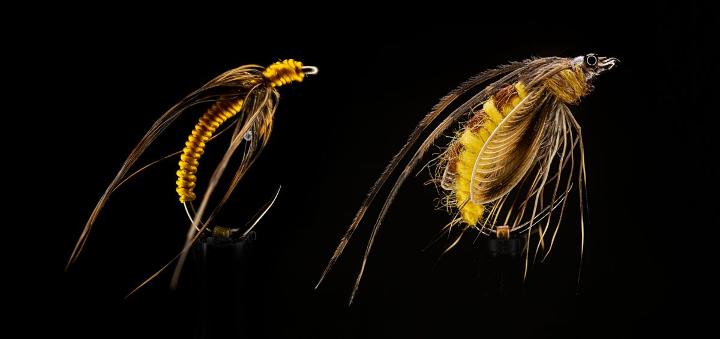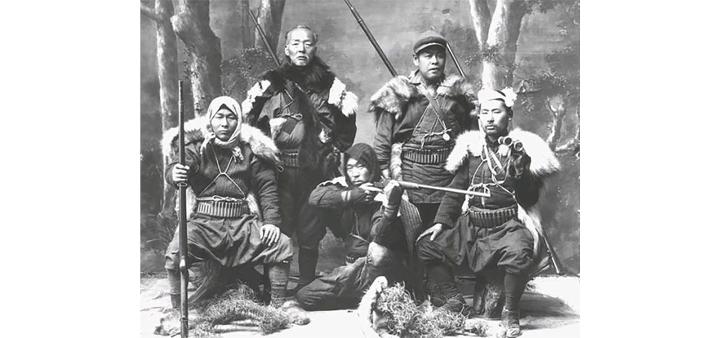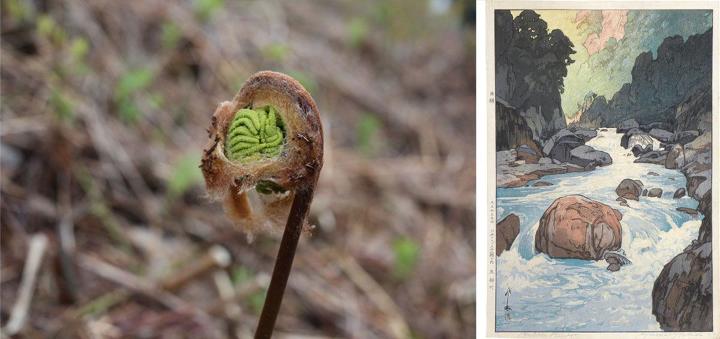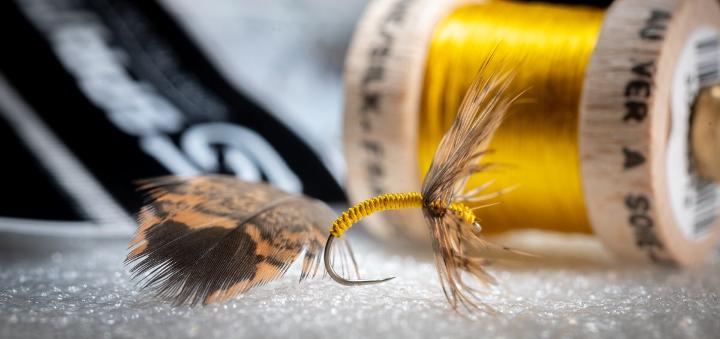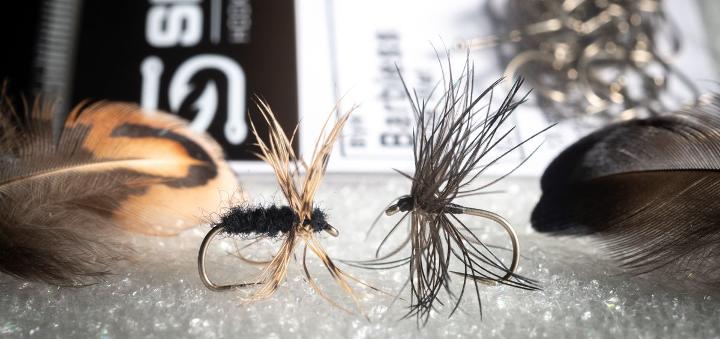A Jun Kebari and an imitation caddis pupa compared.
To better understand the nature of this peculiar difference it may help to know the context in which kebari flies were born and used. Tenkara was born as a subsistence fishing method, mainly used by hunters who lived in the mountain ranges of Japan. During hunting trips there was the need to obtain food without wasting ammunition (arrows and spears) and without using those hunted preys, which were very precious and had to be brought back to the village. Therefore, the main food sources for those hunters were picked herbs, shoots and tubers found in the wood and, whenever possible, they added fish to their diet.
The Matagi, traditional winter hunters of the Japanese mountains (source: fieldethos.com)
A Zenmai sprout (Osmunda Japonica – Japanese flowering fern) (source: designingyourlife.coach) and a painting of the Kurobe River in its torrential stretch (source: ukiyo-e.org)
Over time they eventually understood that in the flowing and impetuous waters of mountain streams in which this fishing was mostly practiced, it was not necessary to perfectly imitate the insect to deceive the fish. Easy to understand the reasons; in the first place because those fishermen mainly focused on very small fish which by their nature are much less suspicious than adult and larger specimens (after all, if I have to eat it is better to catch many small fish than one big one) and, secondly, because in fast moving water current the fish has much less time to think and less visibility, and therefore a limited view of its prey (it is easier to fool it).
With these assumptions, the fisherman was driven to tie lures as simple as possible, leaving out the imitative approach but maintaining those typical peculiarities of insects (shape, size, colour). Instead, he concentrated on making the kebari functional to the manipulation or movement that is given in the water or on the surface, to make the fish perceive them as food and not as simple debris carried by the current.
The search for essentiality has therefore led to the construction of kebari flies simply composed of a body and a feather, more or less rigid, wrapped around the shank of the hook near the eye. This is because the feather can have a double function based on the movement that is given to the kebari.
Sakasa Kebari: Sprite Hook S2100 #12 – Ovale Pure Silk Floss – Woodcock Feather
In the manipulation that brings out the kebari from the bottom towards the surface, the barbs of the feather, due to the upward movement and the contrast of the current, will tend to close on the abdomen, making the lure look like a nymph or a emerging pupa. With a different movement instead, letting the fly descend towards the bottom and downstream, the barbs of the feather open making it look like a terrestrial fallen into the water or a spent or cripple or sunken still-born.In this way a single lure, thanks to its essentiality, if worked in a different way becomes super effective in different fishing situations.
In reality, even in the West, and particularly in the United Kingdom, someone came to the same conclusion and adopted this concept of essentiality applied to fly tying. In the mid-1800s, W. C. Stewart, in a historical period represented by fishing practiced almost always downstream, with imitative lures, with his book “The practical angler; or, The art of trout-fishing, more particularly applied to clear water” figuratively raises his hand, and says: “Gentlemen, look, perhaps all this search for the imitation on the flies is not strictly necessary” and brings the attention back to a model of fly already in use only in the northern countries of England, making it very popular.
This model of fly is the Spider, which in addition to looking very much like a kebari, has the same tying concept (it happens to be used in northern streams similar to the Japanese ones), namely a body and a soft feather wrapped around the shank of the hook. Stewart explains how the Spider can precisely imitate multiple stages of the insect and is very effective when used upstream with movements that animate the fly.
On the same hook (Sprite S2160 #12) two traditional flies are compared: Oni Kebari (Camel Dubbing black and pheasant feather) and Stewart's black Spider (Starling feather)
In any case, the search for essentiality is very typical of the far east countries and in fact it is the basis of Japanese culture and we find it in many aspects related to the artistic tradition, but also more recently to the concept of factory. But it is also fascinating to see how this essentiality is also found in small things, namely in a simple fishing technique, which becomes a perfect combination of three simple elements (rod, line, bait) and in particular, it is found in a tiny hook covered of feathers that was trivially used to obtain food.
